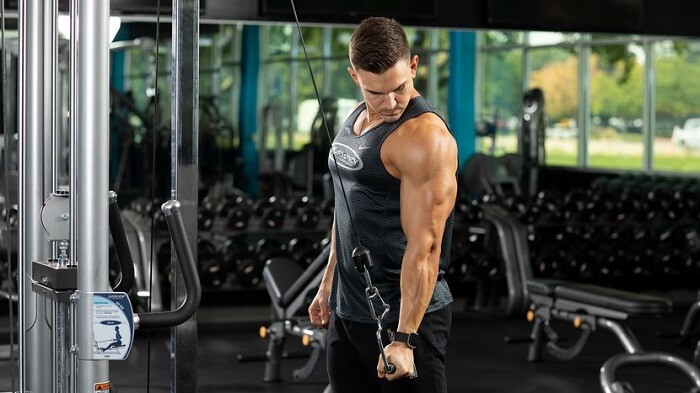HOW MANY WEEKEND PER WEEK?
How many bodybuilding sessions per week do you need to do to progress at best?
At a time when we are all running after time, the question of how many workouts per week to do bodybuilding is at the center of the debate. For those who believe that it is necessary to have at least 5-6 sessions per week and who have 2 to 3 days, we can ask another question: Why start strong and even train in bodybuilding if you train to have no results because you are not doing enough?
That is why in this article I will try to explain to you and offer you practical solutions if you, like all my students, do more than just bodybuilding in your life and still want to progress (if so, it’s possible).
How many bodybuilding sessions per week – the more the better?

When I was a newbie, like many of you, I probably thought physical transformation required a investment without guilt. This is one of the first questions we asked (always asked) an experienced practitioner, “But how many hours do you train each day?
The answer, at least amazing , implies that the person in question is “only exercising” 3 to 5 times a week, which is far from the preconceived ideas we had. Things haven’t changed today. I am amazed at the looks of some who ask me how many times I exercise per week, clearly expecting a “every day” response, and who receive a “4 times a week” response as if they were disappointed with the answer.
Indeed, you must immediately consider the fact that in bodybuilding it is not “the more I do the better”, especially in the medium to long term. A balance must be struck between the “ destruction ” that the workout does, and the “ reconstruction ” that makes active and passive rest.
If we just destroy every day, how can we progress without doping? If we don’t give our bodies time to strengthen, how can we do this? With doping, this is obviously a different story, as evidenced by “Mark” in this podcast:
But, above all, by choosing the path of health and longevity, you will find balance . According to my experience , that is, after teaching several thousand students since 2006, 3 to 4 sessions per week, so that better results are possible and not just progress a little.
Why? Because bodybuilding is an activity that complements our other activities, which can be perceived as limitations in terms of building muscle and strength. Any fatigue, whether morality / psychology affects our overall fatigue and therefore affects our recovery and progress.
Work, family life, social life are all activities that contribute to the progress in bodybuilding of a person who will live only for this “bad”.
But for the average person that we are, these are activities necessary for a fulfilling life, and therefore they include a series of “shortcut” sessions to benefit from the results of our efforts.
How many sessions per week in bodybuilding is a matter of prioritization
When you’re short on time to exercise, it’s important to set priorities to get to the point.
My experience has shown me that apart from professional bodybuilders or people who only live for bodybuilding (in general, it does not last very long, life always ends up catching up with us), the fact is dwelled on the details , which is the work of the upper chest, long biceps, or right earlobe, is a monumental waste of time , especially when you are doing non-doping bodybuilding and the weak points remain weak or nearly weak (see article “How to fill your weaknesses in bodybuilding?”)
To get to the point, you must “quickly” identify the best exercises for yourself based on your morpho-anatomy (you can see the list here) and focus your time on them. Avoid falling into the trap of wanting everyone to work with the same attention, because that is not possible if you only have, for example, 3 slots of one hour a week for training.

This is why we need to focus on them and prioritize its morpho-anatomical analysis to drastically reduce the risk of injury and avoid imbalances that are just waiting to appear. Naturally, therefore, work priorities will be set and will allow you to predominantly request what will actually give you results despite the pressure of time.
In a example , this could mean neglecting biceps and triceps workouts in favor of working on the back and chest, or vice versa. Finally, if you can train “only” three times a week, I advise you to prioritize your shoulders and calves, especially if you don’t have a verified level yet.
Confirmed tier is achieved with Gold tier. This is what I get my students to do successfully. This way the core muscles will have the attention they need to develop at their best (you will have enough time to do enough for them) There are many methods of intensification, and unfortunately most of them are not very interesting for implementation to progress better. Worse, they slow down, see, prevent the creation of benchmarks needed to use progression loops. However, the technique can be interesting when there is not enough time; it is a antagonistic superset .
Classic supersets have many of the disadvantages we’ve seen in this article, but alternating a series, for example, for biceps, and a series for triceps, has the advantage of shortening the session duration. while not reducing its effectiveness.
When you reach the end of a promotion cycle and it takes a long time to recover between sets, it can quickly lengthen the session and become problematic .
That is why, by alternating antagonistic exercises, it allows you not to increase its duration while maintaining the same or almost the same effectiveness. Cardiovascular activity, however, is increasing and should allow, after analysis , not to tie any exercise together.
Alternating insulating drill sets in order, regardless of set length. We should avoid alternating multi-joint exercises in which we are actually doing strength, and this is more if it is in long series, because the cardiovascular system will be the limiting factor, not our muscles, what we want is a prerequisite for progress .
In this case, it is better not to do “too” long series in order to be able (after a short recovery time) to perform a chain of exercises without loss of effectiveness and to try to desynchronize progress cycles, so as not to force “completely” to simultaneously perform two exercises in order to have an opportunity to save time if we miss it because of our goals.
How many bodybuilding sessions per week – What really drives you to gain muscle mass
In addition to the number of resistance training sessions per week, it is important to remember the primary factors that allow you to progress and build muscle. Because no matter how often we train, there can be no physical transformation unless these factors are combined together.
When we practice doping-free bodybuilding, there are 3 interdependent factors:
- Mechanical tension
- Metabolic stress
- Steady progress
Mechanical tension shows the loads that we use, that is, weight, kg. Metabolic stress is the stretch time during a series, that is, the time during which we perform a series, as well as during a session for the same muscle.
Meanwhile, regular progression determines an increase in the two factors mentioned above, which are mainly aimed at increasing mechanical stress without reducing metabolic stress. In other words, we increase the weights that we use without decreasing, in the long term, his number of repetitions, or if we cannot increase his weights, we lengthen our series (for example) in order to be able to increase our loads later.

If you can only do 2 or 3 sessions per session, if you have not configured prioritization , you will easily realize that it will be difficult to get the right stress metabolism for our muscles, i.e. sufficient exercise during the session.
So, we would only combine mechanical stress and progression, which are not optimal for building muscle mass. Progress in loads and repetitions with a small workout volume will be similar to an Athletic Strength workout, resulting in less interesting muscle gains.
This is why you should not hesitate, once again, to neglect some muscles in order to be able to progress on others. This will not stop you from re-evaluating your priorities when you decide that you are advanced enough in a certain area; It combines 3 factors of muscle hypertrophy.
How many sessions per week in bodybuilding – Sample Program
This is a example program with 2 resistance training sessions per week. Obviously, he must be adapted according to his availability and priorities in accordance with his goals, and also look at his morpho-anatomy in order to avoid injury by doing the wrong exercises for himself.
Keep in mind, however, that the less time you have, the more concessions you have to make in order to progress no matter what, hence, for example, only 3 sets per exercise in the program below. If you would like to learn to personalize your bodybuilding program at all levels, know that I have written a book on the subject based on my experience.
Apart from theory, this is primarily practical work that is easy to apply by following various steps that will be beneficial for both diet and weight gain.
| Day 1 | |
| Joint mobilization | 5 minutes |
| Superset Bench Press | 3 sets of 8-12 reps |
| Rowing in the T-Bar | 3 sets of 8-12 reps |
| High pulley pulling force in wide front handle in superset with | 3 sets of 8-12 reps |
| Incline Dumbbell Bench Press | 3 sets of 8-12 reps |
| One-arm dumbbell, dumbbell | 3 sets of 10 to 15 reps |
| Side Dumbbell Raise | 3 sets of 15 to 30 reps |
| Belly Planking – Superset Board with | 3 sets of 1 minute |
| Slanted shell | 3 sets of 30 “on each side |
| Stretching | 5 minutes |
| Day 2 | |
| Joint mobilization | 5 minutes |
| High pulley thrust in superset of superset with | 3 sets of 8-12 reps |
| Spring dips | 3 sets of 8-12 reps |
| Slanted Curl Superset with | 3 sets of 10-20 reps |
| Magic tRYCeps (see exercise) | 3 sets of 10-20 reps |
| Hip Press | 3 sets of 10-20 reps |
| Seated Leg Curl | 3 sets of 10-20 reps |
| Lumbar Bench Extension | 3 sets of 10-20 reps |
| Superset Pool Tape with | 3 sets of 10-20 reps |
| Ground Crisis | 3 sets of 10-20 reps |
| Stretching | 5 minutes |
Conclusion
No matter how much time you have, important is, first of all, a little practice. There is nothing worse than doing nothing, and therefore a person will always be worth more than zero. In addition, beyond these considerations, it is important to understand that muscle gain and progress in the medium to long term are products of consistency say never stop.

This is why it is better to create a program that we can follow, even if it means doing less than optimal, in theory, and sticking to it for several months. It will bring more progress than the program you miss on a regular basis.
